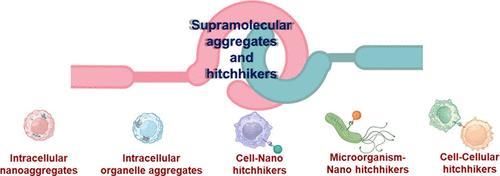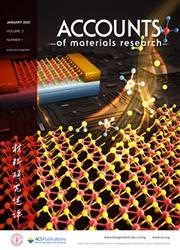Supramolecular Aggregates and Hitchhikers
IF 14
Q1 CHEMISTRY, MULTIDISCIPLINARY
引用次数: 0
Abstract
Supramolecular chemistry is based on intermolecular bonds, where substances dynamically bind together through noncovalent interactions. These dynamic forces allow the macrocyclic molecules and guest molecules to form stable assemblies, with high stability under physiological conditions, making them suitable for in vivo drug delivery. These dynamic noncovalent bonds are easily influenced by external stimuli such as light, heat, pH, and oxidation; thus, the assemblies induced by supramolecular interactions exhibit high diversity and flexibility in response to external stimuli, providing an effective method for simulating natural and physiological processes. The host–guest interactions induced self-assemblies have been applied across multiple dimensions, ranging from the molecular level to the cellular level, for detoxification, targeted drug delivery, and therapeutic studies. At the molecular level, macrocyclic molecules can encapsulate toxic substances from the bloodstream, serving as a solution for emergency detoxification. At the nanoscale level, host–guest interactions can induce the formation of multiple nanostructures including nanomicelles, nanocapsules, nanovesicles, and nanoparticles. The host–guest interactions can enhance the stability of nanostructures and impart them with stimuli sensitivity, which is highly significant in specific microenvironments like tumors. Nanostructures induced by the host–guest interactions possess optimized drug release profiles and pharmacokinetic features, thereby enhancing the therapeutic efficacy while mitigating side effects. At the microscale level, the host–guest interactions can induce the formation of various microassemblies including hydrogels, microfibers, and microtube aggregates. Moreover, microassemblies show superior potential in morphology transformation for controlling cell activity and diseases. Additionally, at the level of biological components, host–guest interactions can induce the assembly of peptides and organelles within cells and having the cell–cell or cell–particle assemblies as hitchhikers at the cellular level. Therefore, this Account aims to summarize the applications of host–guest interactions induced self-assemblies at various levels and the latest research in supramolecular self-assembly, with a particular focus on the progress in our research group. We hope that this account not only reveals the applications of therapeutic supramolecular self-assemblies but also provides new insights into the design of smart drug delivery systems.

超分子聚集体和搭便车者
超分子化学以分子间键为基础,物质通过非共价作用动态地结合在一起。这些动态作用力使大环分子和客体分子形成稳定的集合体,在生理条件下具有很高的稳定性,因此适合体内给药。这些动态非共价键很容易受到光、热、pH 值和氧化等外部刺激的影响;因此,超分子相互作用诱导的组装体在响应外部刺激时表现出高度的多样性和灵活性,为模拟自然和生理过程提供了一种有效的方法。从分子水平到细胞水平,主客体相互作用诱导的自组装已被广泛应用于解毒、靶向给药和治疗研究。在分子水平上,大环分子可以包裹血液中的有毒物质,作为紧急解毒的解决方案。在纳米尺度上,主客体相互作用可诱导形成多种纳米结构,包括纳米小室、纳米胶囊、纳米囊泡和纳米颗粒。主客体相互作用可增强纳米结构的稳定性,并赋予它们对刺激的敏感性,这在肿瘤等特定微环境中意义重大。主客体相互作用产生的纳米结构具有优化的药物释放曲线和药代动力学特征,从而在提高疗效的同时减轻副作用。在微观层面,主客体相互作用可诱导形成各种微组装体,包括水凝胶、微纤维和微管聚集体。此外,微集合体在控制细胞活动和疾病的形态转化方面显示出卓越的潜力。此外,在生物成分层面,主客体相互作用可诱导细胞内肽和细胞器的组装,并使细胞-细胞或细胞-粒子组装体成为细胞层面的搭便车者。因此,本开户绑定手机领体验金旨在总结主客体相互作用诱导的自组装在不同层面上的应用以及超分子自组装的最新研究进展,尤其是我们研究小组的研究进展。我们希望本报告不仅能揭示治疗性超分子自组装的应用,还能为智能给药系统的设计提供新的见解。
本文章由计算机程序翻译,如有差异,请以英文原文为准。
求助全文
约1分钟内获得全文
求助全文

 求助内容:
求助内容: 应助结果提醒方式:
应助结果提醒方式:


